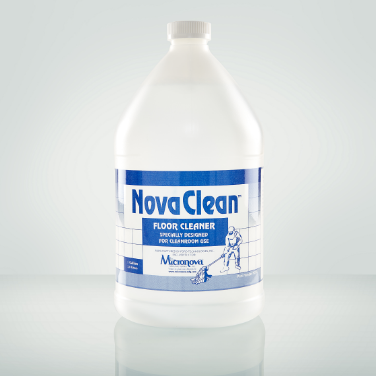Effective Residue Removal: A Critical Step
Understanding the type of residue is important when determining which materials and detergents will be most effective. Mechanical action by personnel is needed to remove visible and sub-visible production debris, cleaning agent residue, equipment marks, and contamination. Fabrics with abrasive and absorbent properties as well as specialized detergents may be needed to perform an extra level of cleaning, without the need to scrub, in clean production areas.
A Clean Comparison
The data below shows a series of common cleanroom fabrics (ISO 5 to 9) compared to a generic 100 percent polyester fabric (control), using 70 percent IPA to remove dried surface residue (a fine white powder) from a 5,000 parts per million (ppm) sodium hypochlorite (bleach) solution.
Microfiber—a highly absorbent, slightly tufted 80 percent polyester/20 percent nylon fabric—was twice as effective as the control fabric. Microfiber with PolyMesh™—a microfiber fabric with a layer of polyester braid—also removed a significant amount of the visual residue with its added scrubbing factor. NovaScrub™—a durable open-pore reticulated foam—excelled at loosening the dried residue, however, more of it was visible after drying, similar to the results of the polyester control. Refer to the table for more details.
Dislodging Residue and Debris
Due to high levels of volatile organic compounds (VOCs), 70 percent IPA solutions are not practical for residue removal on large surfaces. Detergents with surfactants that dislodge residue and debris are preferred when cleaning or disinfecting.
One such cleaner is Micronova™ NovaClean™. Filtered to 0.1 μm and containing metals and common salt ions in the parts per billion (ppb) range, it cleans surfaces without leaving significant residue.
A second comparison shows the effectiveness of NovaClean detergent compared to deionized (DI) water as solutions to remove residue of a standard quaternary disinfectant, using the same range of fabrics discussed above. Again, the slightly tufted microfiber fabric fared the best, this time leaving an impressive zero percent residue of the standard disinfectant with NovaClean as the surfactant. Several fabrics popular in aseptic areas to apply disinfectants also worked well with NovaClean to remove any disinfectant residue. Other materials—PolySorb™, a textured polyester; MegaTex™, a textured polyamide; and NovaPoly™, a knit polyester—performed much better with NovaClean than the control. The polyester control fabric combined with DI water only removed about 50 percent of the disinfectant residue, compared to 75 percent removal when using NovaClean as the solution.
Recommendations
As you devise your plan for routine residue removal, consider the type of residue, the fabric to remove that residue, and the cleaning solution.
Tufted microfibers, such as Micronova™ microfiber fabric, work well at eliminating both salt and solution residues.
NovaClean detergent is superior to DI water for removing residue from quaternary amine type disinfectants. For dried salts or slurries, NovaScrub or other more abrasive fabrics are a good choice. When using NovaClean or another disinfecting detergent for residue removal, low particle-shedding fabrics like PolySorb or MegaTex may be preferred since they can also be used to apply disinfectants.
Average Visible Residue Remaining After Wiping
| Wiping Fabric | 5% (v/v) Sodium Hypochlorite* | 1.6% (v/v) Quaternary Ammonium Disinfectant |
|---|---|---|
| 70% IPA | NovaClean | |
| Control Fabric: 100% Polyester | 25% | 25% |
| Microfiber | 12.5% | 0% |
| Microfiber with Braided Polyester | 17.5% | 15% |
| Reticulated Dry Foam | 25% | 25% |
| Textured Polyester | 30% | 10% |
| Textured Polyamide | 12.5% | 0% |
| Microfiber | 42.5% | 15% |
| Knit Polyester | 30% | 15% |
| Wiping Fabric | 1.6% (v/v) Quaternary Ammonium Disinfectant | |
|---|---|---|
| DI Water | NovaClean | |
| Control Fabric: 100% Polyester | 50% | 25%** |
* 5,000 ppm diluted bleach **50% residue reduction using NovaClean




